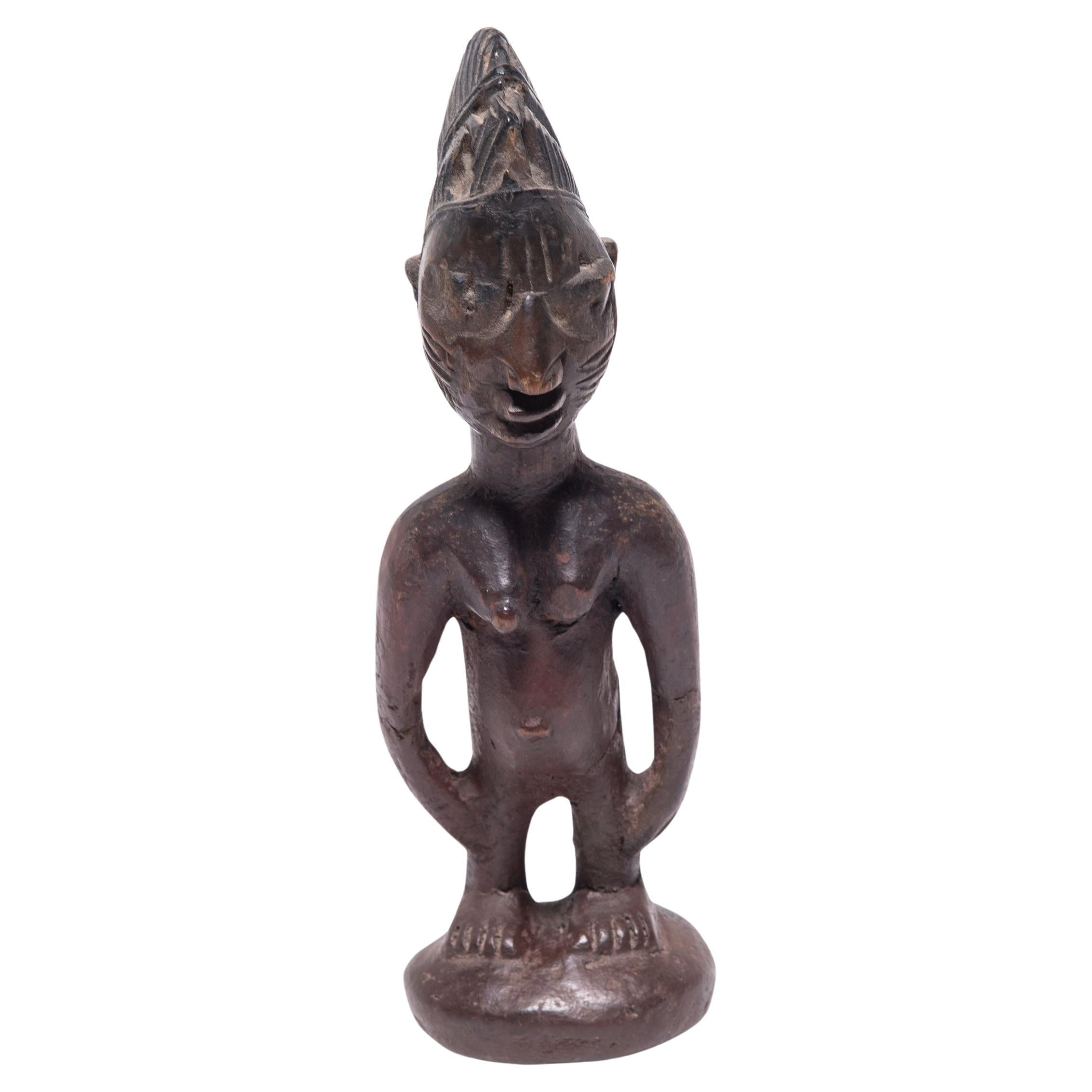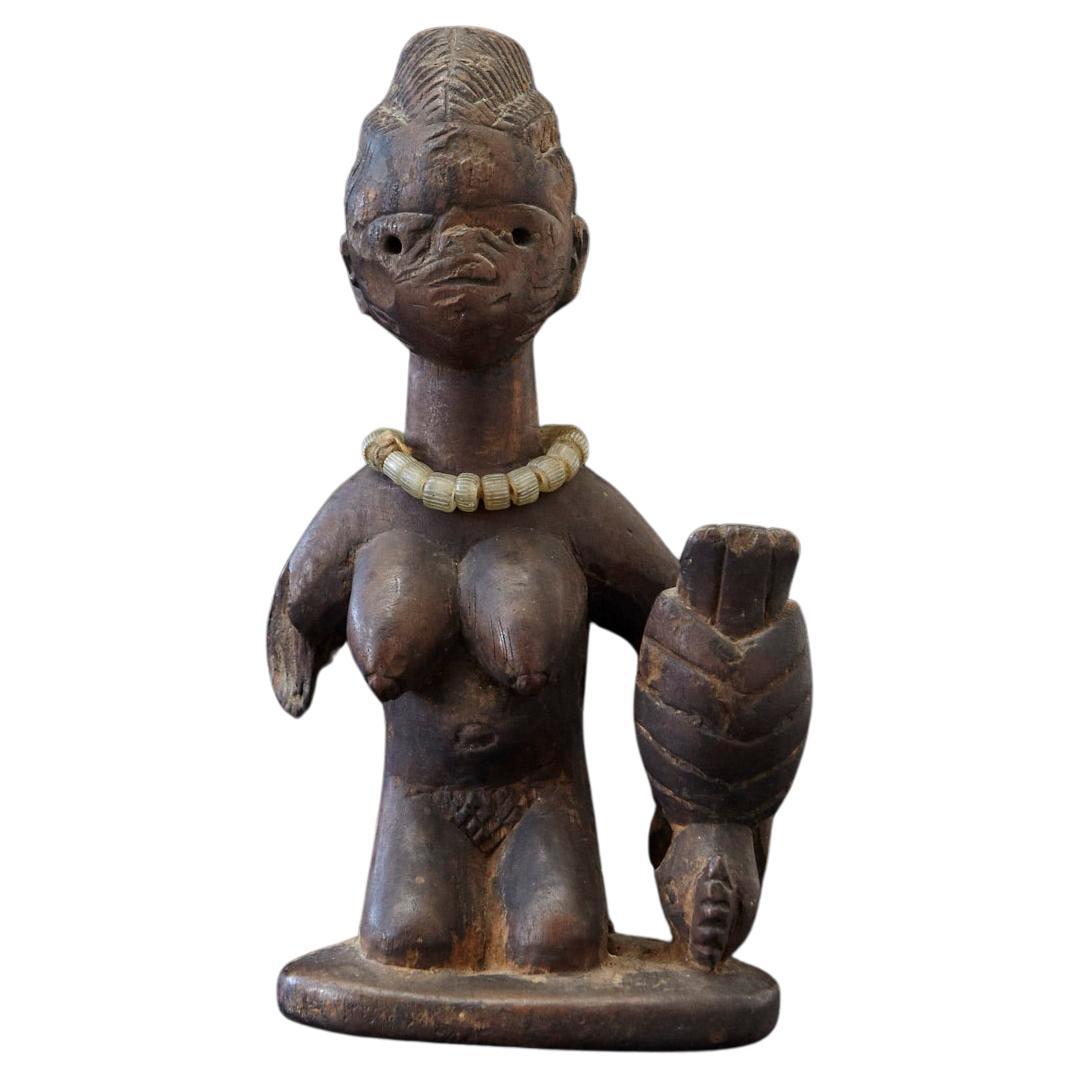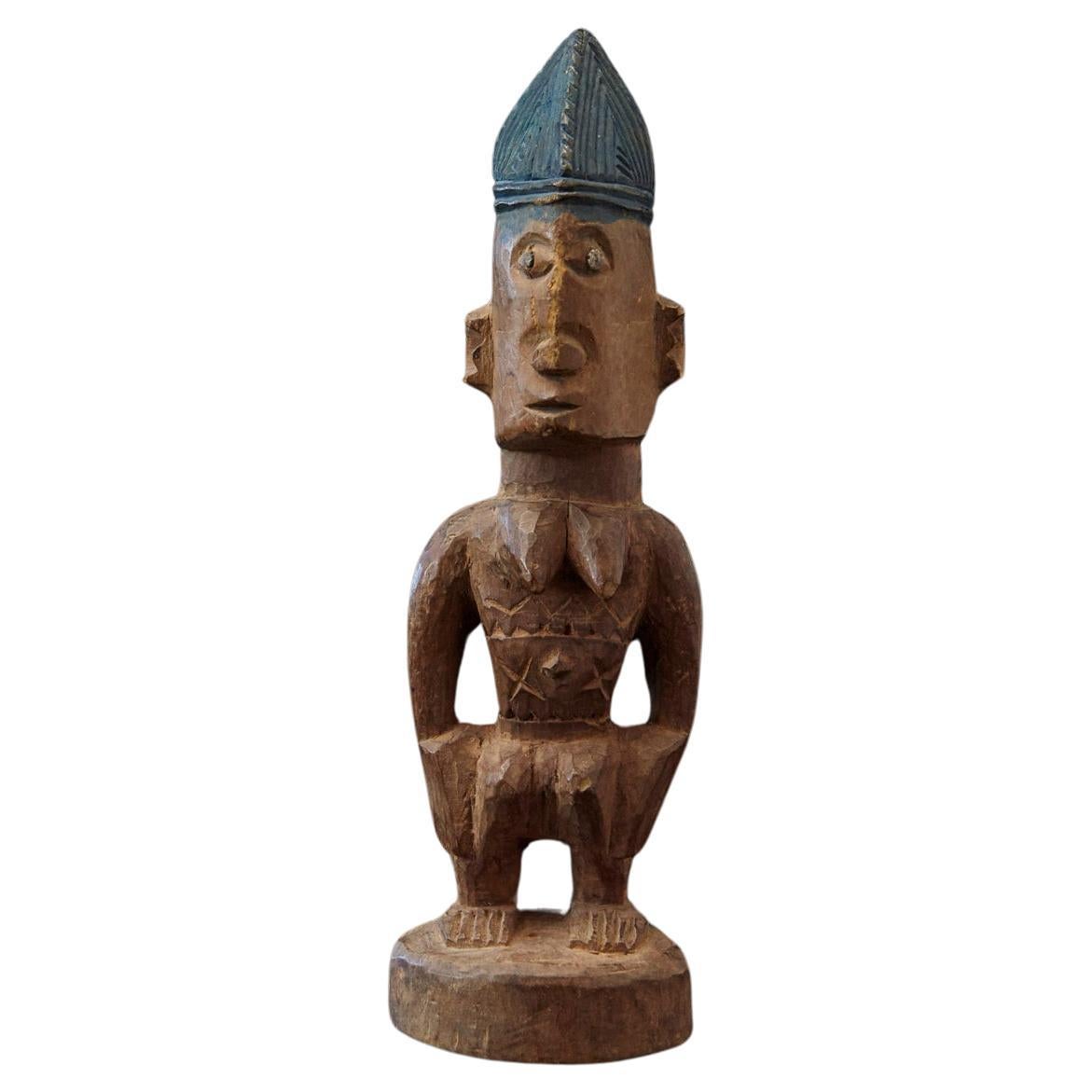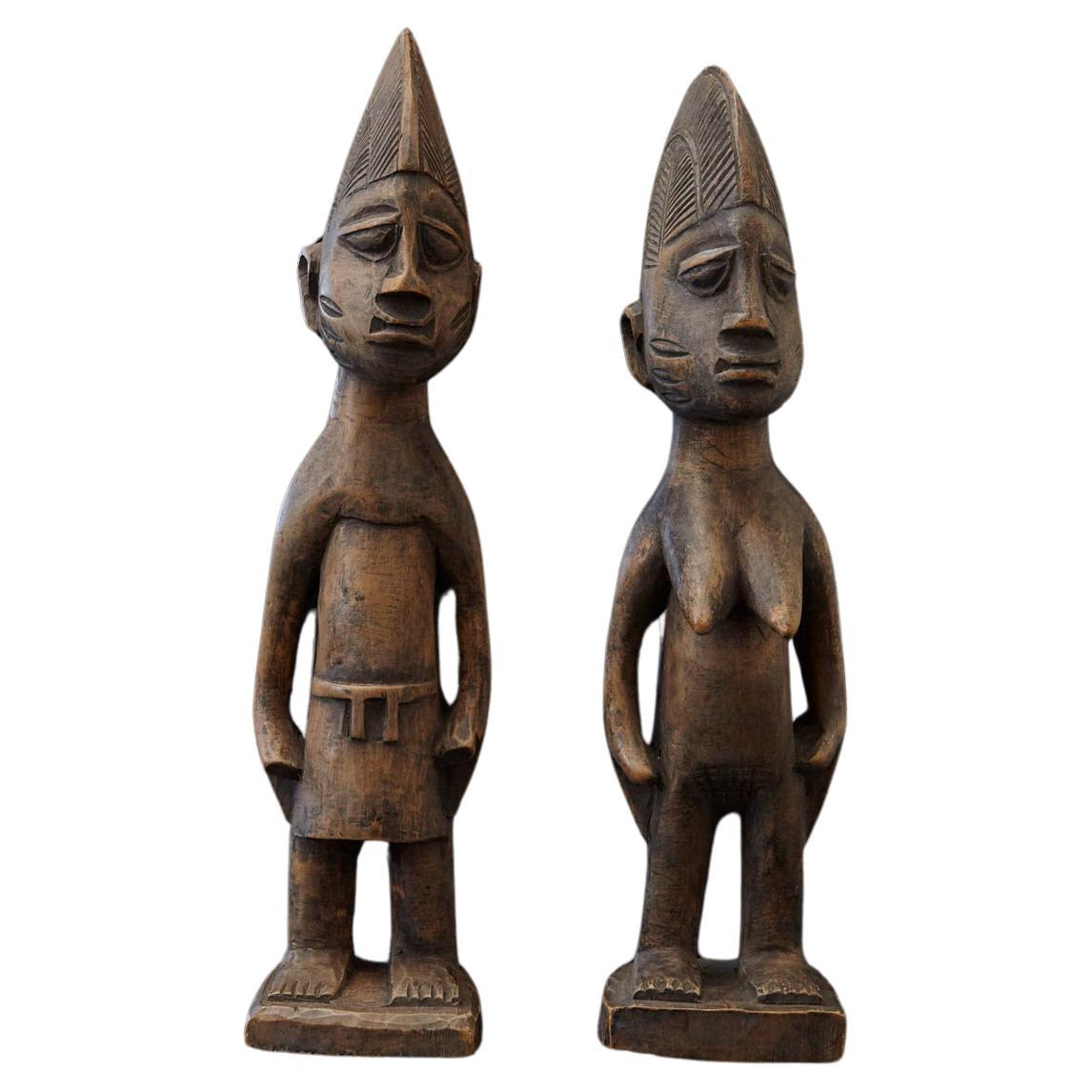Items Similar to Carved Twin figure Ibeji Yoruba People, Nigeria
Want more images or videos?
Request additional images or videos from the seller
1 of 9
Carved Twin figure Ibeji Yoruba People, Nigeria
About the Item
A finely carved significant Yoruba Male Ibeji figure with a tall headdress, expressive eyes, original bead belt and heavy wear and polish from native use. Areas of encrusted camwood powder between arms and around feet. Though the cause of the high rate of twin births among Yoruba women has not been established, the cultural grieving process is well documented. It may be observed in the carving of a figure known as Ere Ibeji, representing the lost child and serving as a ritual point of contact with the deceased's soul. The carving of the Ere Ibeji is commissioned under the guidance of an Ifa diviner, a Babalawo, whom the parents consult in selecting the particular artist who will do the work. The sculpture itself represents a deceased infant but is carved with features and attributes of an adult. The sculptural features of genitalia, pubic hair, wide hips, developed breasts, gender-specific facial scarification and mature coiffures exude erotic sexuality, uncommon for infants. The completed ibeji figure is carved as an adult rather than as the deceased infant, in a mythological form that depicts the concentrated calm of a Yoruba artist. When the carving of the Ere Ibeji is completed, the artist is given a feast and payment as determined by the Orishas.
Once the figure is brought to the family dwelling, it is placed on a shrine dedicated to Elegba, hoping that the Orisha or soul, split into two parts when the twins were born, will now again reside in the figure that represents the dead twin. The sculpted figure is treated and cared for as if it were alive. It is rubbed in sacramental oil, washed, fed, clothed, sung to and prayed to. It is kept standing during the day and is laid down at night.
Often it will be dressed in the same clothing as the living twin or be decorated in a beaded vest or shown with raised sandals, indicating possible royal connections. They watch the figure as if it was their child; they feed and wash it. It will be constantly rubbed with indigo and redwood powder. The responsibility of caring for the Ibeji is borne by the mother and female family members of subsequent generations. The sculpture is expected to avert evil from the household, strengthen the manifestations of family love, stare down death, illuminate the pathway through the valley of immortality, and bring good fortune to all who treat it with respect and offer it tokens of affection.
- Dimensions:Height: 26 in (66.04 cm)Width: 9 in (22.86 cm)Depth: 8 in (20.32 cm)
- Materials and Techniques:
- Place of Origin:
- Period:
- Date of Manufacture:1920/1930
- Condition:Wear consistent with age and use.
- Seller Location:Leuven , BE
- Reference Number:
About the Seller
5.0
Gold Seller
These expertly vetted sellers are highly rated and consistently exceed customer expectations.
Established in 2017
1stDibs seller since 2017
163 sales on 1stDibs
Typical response time: 1 hour
- ShippingRetrieving quote...Ships From: Leuven , Belgium
- Return PolicyA return for this item may be initiated within 3 days of delivery.
More From This SellerView All
- Pair of Decorative Figures ScuIptures Ibeji Twin Figures, Yoruba people NigeriaLocated in Leuven , BEA pair of female ‘ibeji’ twin figures of the Yoruba people. From south-west Nigeria . Both ‘ibeji figures’ wear a high plaited coiffure, coloured blue by m...Category
20th Century Nigerian Figurative Sculptures
MaterialsWood
- Yoruba-Egba couple of Ere Ibeji Twin Figures signed by Akinyode, Yoruba PeopleLocated in Leuven , BEYoruba Egba, couple of Ere Ibeji Twin Figures signed by Akinyode ,Yoruba People, Nigeria Abeokuta Provenance Monique Lancée (Maastricht '80)Category
Early 20th Century Nigerian Figurative Sculptures
MaterialsWood
- Haussa People, Nigeria, Dagger with Organic HandleLocated in Leuven , BEBeautifully crafted dager from Nigeria (Haussa People) with an organic handle. Hausa people are frond in northwestern Nigeria and adjacent southern Ni...Category
20th Century Nigerian Tribal Art
MaterialsMetal
- Ibibio Anthropomorphic Standing Male Janus Figure, NigeriaLocated in Leuven , BEThis elaborate Janus statue is a rare example of an Ibibio free-standing figure to recall a well-defined ancestor in what seems a European outfit .The Ibibios lend supernatural power...Category
20th Century Congolese Tribal Art
MaterialsWood
- Ethno Design Mbole People, DRC, Chief Scepters Collection Made of Palmtree LeafLocated in Leuven , BEThe Sceptres are made of the Midrib of Palm tree leaves. They were uses by the members of the Lilwaa Secret Society of the Mbole Tribe that live in the ...Category
Vintage 1920s Congolese Tribal Art
MaterialsOrganic Material
- Ethno Design Selection of 7 Cache-Sexe Made of Palm Leaf, Mangbetu People, DRCLocated in Leuven , BEBack aprons (negbe, pl. egbe) such as these were particularly popular among upper-class Mangbetu women at the turn of the 20th century. This distinctive kidney-shaped ornament pad wa...Category
Vintage 1930s Congolese Natural Specimens
MaterialsOrganic Material
You May Also Like
- Yoruba Ibeji Twin FigureBy Yoruba PeopleLocated in Chicago, ILWith one of the highest rates of twin births in the world, Yoruba cultures place special social and religious significance on twins, referred to as "emi alagbara" or "powerful spirit...Category
Mid-20th Century Nigerian Tribal Tribal Art
MaterialsWood
- Ere Ibeji Female Commemorative Figure, Egba, Yoruba People, Nigeria, 20th CBy Yoruba PeopleLocated in Aramits, Nouvelle-AquitaineYoruba people have one of the highest incidents of twin births in the world. As a result, twin children are regarded as extraordinary, divine beings protected by Sango, the deity of ...Category
Mid-20th Century Nigerian Tribal Tribal Art
MaterialsWood
- Ere Ibeji Male Commemorative Figure, Yoruba People, Nigeria, early 20th CBy Yoruba PeopleLocated in Aramits, Nouvelle-AquitaineYoruba people have one of the highest incidents of twin births in the world. As a result, twin children are regarded as extraordinary, divine beings protected by Sango, the deity of ...Category
Early 20th Century Nigerian Tribal Tribal Art
MaterialsWood
- Ere Ibeji Female Commemorative Figure, Yoruba People, Nigeria, early 20th CBy Yoruba PeopleLocated in Aramits, Nouvelle-AquitaineYoruba people have one of the highest incidents of twin births in the world. As a result, twin children are regarded as extraordinary, divine beings protected by Sango, the deity of ...Category
Early 20th Century Nigerian Tribal Tribal Art
MaterialsWood
- Ere Ibeji Pair of Commemorative Figures, Ogbomosho, Yoruba People Nigeria 20th CBy Yoruba PeopleLocated in Aramits, Nouvelle-AquitaineYoruba people have one of the highest incidents of twin births in the world. As a result, twin children are regarded as extraordinary, divine beings protected by Sango, the deity of ...Category
Mid-20th Century Nigerian Tribal Tribal Art
MaterialsWood
- Ere Ibeji Pair of Commemorative Figures, Oshogbo, Yoruba People, Nigeria, 20th CBy Yoruba PeopleLocated in Aramits, Nouvelle-AquitaineYoruba people have one of the highest incidents of twin births in the world. As a result, twin children are regarded as extraordinary, divine beings protected by Sango, the deity of ...Category
Vintage 1960s Nigerian Tribal Tribal Art
MaterialsWood





